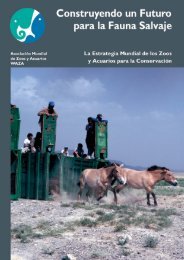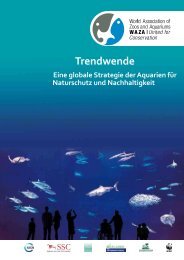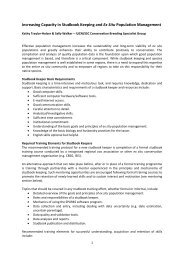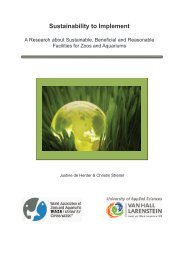Towards Sustainable Population Management - Waza
Towards Sustainable Population Management - Waza
Towards Sustainable Population Management - Waza
You also want an ePaper? Increase the reach of your titles
YUMPU automatically turns print PDFs into web optimized ePapers that Google loves.
WAZA magazine Vol 12/2011<br />
Jonathan D. Ballou 1 * & Kathy Traylor-Holzer 2<br />
Captive <strong>Population</strong>s<br />
and Genetic Sustainability<br />
Introduction<br />
Conservation biologists have long<br />
been interested in the questions of<br />
population viability and sustainability.<br />
The concept of Minimum Viable<br />
<strong>Population</strong> (MVP) size was first developed<br />
to answer the question of how<br />
large a population needs to be to survive.<br />
Quantitatively, MVP is usually<br />
expressed as: “How large does this<br />
population need to be to have 95%<br />
(or some similar percentage) chance<br />
of surviving for 100 years (or some<br />
moderately extended timeframe)?”<br />
Computer modelling (population viability<br />
analysis [PVA]) is typically used<br />
to answer this question, the reliability<br />
of which critically depends on the<br />
amount of detailed data available for<br />
the population. PVA has now become<br />
a standard tool for use in wildlife<br />
conservation.<br />
1 Smithsonian Conservation<br />
Biology Institute,<br />
Washington, DC, USA<br />
2 IUCN/SSC Conservation<br />
Breeding Specialist Group,<br />
Apple Valley, MN, USA<br />
* E-mail for correspondence:<br />
ballouj@si.edu<br />
Soon after the development of<br />
organised captive breeding programmes<br />
in the early 1980s (e.g.<br />
the European Endangered Species<br />
Programme [EEP] of the European<br />
Association of Zoos and Aquaria<br />
[EAZA] and the Species Survival<br />
Plan [SSP] of the Association of<br />
Zoos and Aquariums [AZA] in North<br />
America), zoo biologists also began<br />
wondering about MVPs for captive<br />
populations. How large should our<br />
captive populations be? We asked<br />
a number of prominent conservation,<br />
wildlife and zoo biologists to address<br />
this question at a workshop hosted<br />
by the Smithsonian National Zoo’s<br />
Conservation and Research Center<br />
in 1986. Their recommendation was:<br />
large enough to maintain 90% of the<br />
source population’s genetic diversity<br />
for 200 years (Soulé et al. 1986). The<br />
authors clearly recognised that these<br />
metrics were somewhat arbitrary,<br />
but nevertheless felt that they were<br />
in the right ballpark. Ninety percent<br />
because this represents “the zone<br />
between a potentially damaging and<br />
a tolerable loss of heterozygosity”.<br />
Potentially damaging because a loss<br />
of 10% of the genetic diversity is<br />
roughly equivalent to an increase in<br />
the average inbreeding coefficient in<br />
the population of 10% and approaches<br />
the level at which individuals are as<br />
related as half siblings, and we know<br />
that inbreeding decreases the health<br />
of populations (Frankham et al. 2010).<br />
200 years because it “is a reasonably<br />
conservative temporal horizon…<br />
A longer time ignores the exponential<br />
rate of progress in biological technology”.<br />
The reference to biotechnology<br />
being the benefits of realised<br />
and expected future advances in the<br />
science of storing and regenerating<br />
embryonic cells, and hence a lesser<br />
need for living captive populations to<br />
act as genetic reservoirs for threatened<br />
species. The authors allowed<br />
for disagreement with these metrics<br />
and proposed them as a first step in<br />
the process of determining MVPs<br />
for captive populations. Additionally,<br />
while the metrics are genetic, it was<br />
assumed that genetic criteria for viability<br />
would be stricter than demographic<br />
criteria, and any population<br />
that satisfies the genetic goals would<br />
very likely satisfy any demographic<br />
goals as well (such as those above for<br />
MVPs).<br />
19<br />
»

















